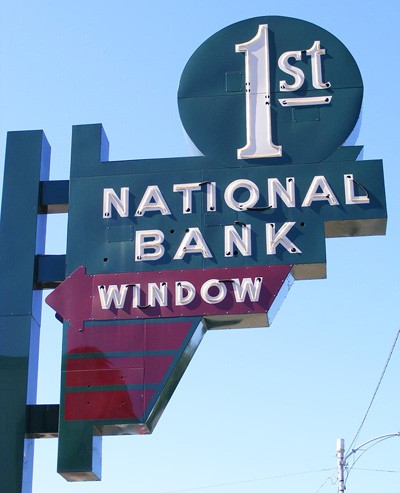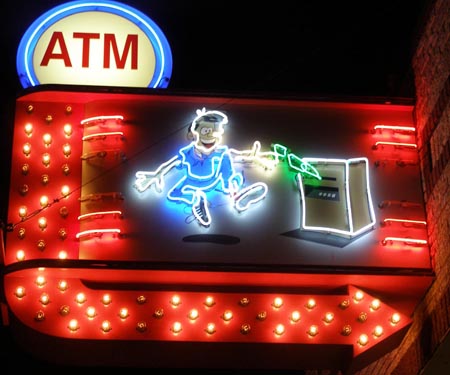Banking surely is a beat with a language all its own. This is a list of some of the key terms you’ll need to know and will come across frequently. The three sites I consulted in the arrangement of this glossary, are named below.
Asset—Anything on the balance sheet with value to the company. In banking, this includes loans, which can be a little confusing since loans involve money that a bank has departed with for the benefit of a borrower. But because that money is lent out with the expectation that it will return to the balance sheet eventually, it’s an asset, just like the securities (Treasury bonds and the like) that a bank might own.
Bank Holding Company—A company that controls a bank (or several banks) but is not necessarily chartered itself to operate a bank; a structure favored because of the relative ease with which a bank holding company, as compared to an actual bank, can raise capital. Bank holding companies are regulated by the Federal Reserve, although the banks they own may primarily be under the supervision of another agency, such as the OCC or FDIC.
Basel Committee on Banking Supervision—An international forum for bank supervisory authorities. Administered from Basel, Switzerland, the committee sets capital adequacy standards and other guidelines intended to enhance cross-border synchronization of bank regulations.

CAMEL—An acronym for the rating system that federal regulators use for their examinations of banks (banks are evaluated based on their Capital, Asset quality, Management, Earnings and Liquidity)
Capital—All of the equity in a firm; for banks this generally means common and preferred shares, surplus capital and profits
Capital markets—Markets where companies or governments can raise long-term funds, i.e. debt and equity. An alternative to bank borrowings for companies that are not self-financed.
Capital ratio—A measure of a bank’s financial health. There are many different types of capital ratios. Commonly cited ratios include the Tier 1 capital ratio, which is Tier 1 capital dividend by risk-adjusted assets; the leverage ratio, which is Tier 1 capital divided by average total consolidated assets; and the so-called Texas ratio, which divides nonperforming assets plus real estate owned by the sum of tangible common equity and loan-loss reserves. See individual entries for each term listed here in bold.
Certificate of deposit—A deposit for a specified term that earns interest at a specific rate; CD terms can be as short as one week or longer than 10 years, with rates generally rising the longer-dated the deposit is.
Commercial bank—A financial institution that offers a broad range of services, typically including checking and savings accounts, credit cards and business loans; see entry for investment bank to better understand the difference between commercial and investment banks.Charter—The legal authorization, granted by a federal and/or state regulatory agency, for a bank to conduct its business. All banks must be chartered. National banks are chartered by the Office of the Comptroller of the Currency (OCC); the Federal Reserve System charters institutions known as state-member banks; and the FDIC charters insured banks; some state-chartered banks are chartered by state regulatory agencies.
CRA/Community Reinvestment Act—A federal law that requires banks to lend in the areas where they take in deposits; intended to spur investment in poor communities and neutralize biases that might hamper investment in neighborhoods with high concentrations of minorities.
CRE—Bank-speak for commercial real estate
Credit Risk—The risk that a borrower or counterparty fails to follow through and make good on an obligation
Credit Union—A nonprofit cooperative owned by its users; usually for employees of the same company, or members of the same union, etc. Credit unions get tax benefits that allow them to generally offer lower rates and fees than banks, but credit unions have not been without their problems as a result of the recent crisis
Demand deposit—A deposit that can be withdrawn on demand, without penalty; this usually is a deposit in a checking account (also known as a DDA, demand deposit account)
Depository institution—An institution that is permitted to take deposits
Dodd-Frank Act—The omnibus financial reform bill passed by Congress in July 2010 in response to the financial crisis; named for Chris Dodd and Barney Frank, the respective chairmen at the time of the Senate Banking Committee and House Financial Services Committee, the bill established the Consumer Financial Protection Bureau, a new arm of the Federal Reserve; it abolished the Office of Thrift Supervision, the regulator for savings and loans; it created a Financial Stability Oversight Council, tasking representatives of financial regulators to identify and respond to emerging risks to the financial system; and authorizes a wind-down process for large institutions that might otherwise have been considered “too big to fail” (the effectiveness of which cannot be measured until the next failure of a giant institution).
Durbin Amendment—A last-minute addition to the Dodd-Frank Act that instructed the Federal Reserve to cap debit card swipe fees (also known as debit interchange). The amendment, sponsored by Illinois Sen. Dick Durbin, was strongly opposed by bankers and their supporters on Capitol Hill, which worried that the fee cap would prevent banks from covering the cost of providing debit interchange services to merchants that accept debit cards. (The Fed ultimately set a cap of 21 cents per swipe, plus 0.05% of the transaction amount; this may not allow banks to recoup the full cost of interchange when factoring in costs like fraud protection, but it’s higher than the 12-cent cap initially proposed by the Fed.)
Enforcement action—A measure taken by a regulator against an institution for a violation of laws, capital rules, unsound practices, etc. May be preceded by an informal action, frequently referred to as a Memorandum of Understanding, or MOU. Formal enforcement actions are available to the public. For a database of OCC enforcement actions.
Fannie Mae/Freddie Mac—government-sponsored enterprises (GSEs) started by the federal government to facilitate financing for housing; Fannie (formally known as the Federal National Mortgage Association) and Freddie (the Federal Home Loan Mortgage Corporation) were put into conservatorship in 2008, when the government stepped in to guarantee the debt of the GSEs.
FDIC (Federal Deposit Insurance Corp.) —The federal agency that insures deposits in banks and thrifts up to $250,000 per customer; the agency also regulates more than 4,900 banks and savings institutions, and is the primary regulator of banks that are chartered by states but choose not to join the Federal Reserve System. For more about the FDIC.
Federal funds (aka fed funds) —Short-term loans between banks; these funds are not guaranteed by the Fed or the federal government, but are exchanged between banks by transferring balances from the lender’s account at its Federal Reserve district bank to the borrower’s account at its Federal Reserve district bank
Federal funds rate—Rate at which overnight fed funds are traded
Federal Reserve—The federal agency responsible for conducting monetary policy (with the twin objectives of stable prices and maximum employment) and tasked with regulating certain kinds of banking institutions and maintaining the stability of the financial system. Business writers may be accustomed to following the Fed in terms of the macro-economic environment; from a banking beat perspective, it’s important to know that in addition to setting benchmark interest rates and the like, the Federal Reserve Board and its network of district banks (i.e. the New York Fed, the Atlanta Fed and so forth) has supervisory authority over 900 “state member” banks and 5,000 bank holding companies—and, under Dodd-Frank, any financial institution (even non-banks) that are considered systemically important.
Interchange fee—The fee that a merchant’s bank pays to a customer’s bank when the customer uses a debit or credit card to pay for a transaction; see entry for Durbin Amendment.
Interest rate risk—The risk that an investment’s value will change because of a change in the interest rate environment; for banks, this primarily is a concern
Liability—An obligation. In banking, this includes deposits.
Loan Loss Provision—An expense set aside to cover bad loans.
Net interest margin—The different between the interest a bank earns on its assets (loans, securities and investments) and the interest it pays out to depositors. Often referred to as NIM, this is a key measurement of a bank’s health and is talked about frequently in the context of rising or falling interest rates.
Nonperforming Asset or Nonperforming Loan—An asset (usually a loan) that is in default or otherwise not producing any income for the bank.
OCC — Office of the Comptroller of the Currency; the Treasury Department bureau that is the chartering authority and supervisor for nationally chartered banks
Overdraft—The amount by which withdrawals from a checking account exceed funds available in the account; in the aftermath of the credit crisis, the Fed changed the overdraft rules known as Reg E to make overdraft policies more transparent to bank customers
Payments system—A system that allows for the exchange of debits or credits; the broad term used to describe debit- and credit-card systems.
Private bank—A bank, or division within a bank, that offers personalized services to affluent customers.

Private equity—An investment in equity that is not quoted on a public exchange; private equity firms have become more entrenched in banking in recent years by acquiring stakes (or in some cases buying companies outright) in distressed-bank situations
Regulation E — See entry for “overdraft”
Savings and loans — Specialized banks, also known as thrifts, that were formed to promote savings and affordable home ownership; the S&L crisis of the 1980s occurred after thrifts were allowed to invest in risky commercial ventures.
Syndicated loans — Loans that are extended by a group of banks (but administered by a smaller group of banks, or an individual bank); the pooling of credit helps banks to spread risk and helps to support giant funding packages for large borrowers
TARP/Troubled Asset Relief Program — The federal bailout program devised in 2008 to help ease the credit crisis. Most large banks have repaid their TARP funds, but many credit extensions made under this program remain outstanding.
Tangible Common Equity — Shareholders’ equity that is NOT preferred equity or intangible assets. This figure essentially indicates what owners of common stock in a bank would receive in the event of the bank’s liquidation. Of course, often what common stockholders receive in the event of liquidation is nothing. TCE was very much in vogue during the 2008 credit crisis, but since then the fixation on TCE seems to have been replaced (and probably with good reason) with a fixation on Tier 1 capital (see separate entry below).
Texas Ratio — A ratio commonly examined for risk of bank failure. The ratio is calculated by dividing nonperforming assets by the sum of tangible common equity and loan-loss reserves. When the ratio approaches 1:1, or 100 percent, the bank often is at or near the tipping point for failure.
Tier 1 Capital — A core measure of a bank’s health; this includes equity capital (common shares etc.) and reserves. The ratio of Tier 1 capital to total risk-weighted assets is known as the Tier 1 capital ratio and it must be at least 6 percent to meet coming regulatory standards. Under new bank regulation rules, what qualified as Tier 1 capital in the past won’t necessarily quality as Tier 1 capital in the future; regulators are building a stricter interpretation of what counts as Tier 1 capital.
Sites consulted in the arrangement of this glossary include:










